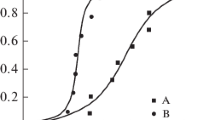Conclusions
-
1.
The temperature dependence of the rate of low plastic strains determined at the stresses below the yield stress is the strain characteristic of the structure of the material and the temperature spectrum of the strain rates determining the ‘mobility’ or relaxation capacity of the structure.
-
2.
We detected the nonmonotonic nature of the\(\dot \varepsilon \left( {\rm T} \right)\) dependence, indicating that the processes of local plastic deformation are rapidly activated at certain temperatures.
-
3.
It is shown that the form of the\(\dot \varepsilon \left( {\rm T} \right)\) dependence and the position of the maxima of\(\dot \varepsilon \left( {\rm T} \right)\) are only slightly sensitive to the surface state and the sign and magnitude of applied load but respond to the variation of the structure as a result of heat treatment. They also differ for steels of various grades.
-
4.
The critical brittleness temperature can be determined on the basis of the temperature of the peak of\(\dot \varepsilon \left( {\rm T} \right)\) in the expected temperature range of the ductile-brittle transition. The estimation of this temperature by the method described above and by the existing methods for a number of cases where the existing methods confirmed their reliability indicates that\({\rm T}^{\dot \varepsilon } \) can be used as the characteristic of the brittle fracture resistance of the material.
Similar content being viewed by others
Literature Cited
N. A. Makhutov, “Methods of determining critical brittleness temperatures for materials and structural members,” Zavod. Lab.,45, No. 9, 78–81 (1981).
M. N. Georgiev, “Comparison of various critical brittleness temperatures of low-carbon low-alloy steels,” Zavod. Lab.,47, No. 11, 78–80 (1983).
V. I. Trefilov, Yu. V. Mil'man, and S. A. Firstov, Physical Fundamentals of the Strength of Refractory Metals [in Russian], Naukova Dumka, Kiev (1975).
Yu. Ya. Meshkov, “Structural fundamentals of prediction of the structural strength of steels,” Metallofizika,6, No. 1, 80–83 (1984).
N. N. Peschanskaya, G. S. Pugachev, and N. P. Yakushev, “Application of the inferrometer for accurate determination of the creep rate,” Mekh. Polim., No. 2, 357–358 (1977).
M. A. Krishtal, S. A. Golovin, and V. P. Pudoveeva, “Variation of the cold brittleness threshold of the metal by the internal friction method,” in: Relaxation Phenomena in Metals and Alloys [in Russian], Metallurgizdat, Moscow (1963), pp. 120–122.
H. Wiedersich, “A quantitative theory for the dislocation multiplication during the early stages of the formation of glide bands,” J. Appl. Phys.,33, No. 3, 854–858 (1962).
Additional information
Physicotechnical Institute, Academy of Sciences of the USSR, Leningrad. Translated from Problemy Prochnosti, No. 7, pp. 115–119. July, 1987.
Rights and permissions
About this article
Cite this article
Peschanskaya, N.N., Shpeizman, V.V., Andreev, A.K. et al. Evaluation of the brittle fracture susceptibility of steels on the basis of the spectrum of low strain rates. Strength Mater 19, 1016–1022 (1987). https://doi.org/10.1007/BF01523548
Received:
Issue Date:
DOI: https://doi.org/10.1007/BF01523548




